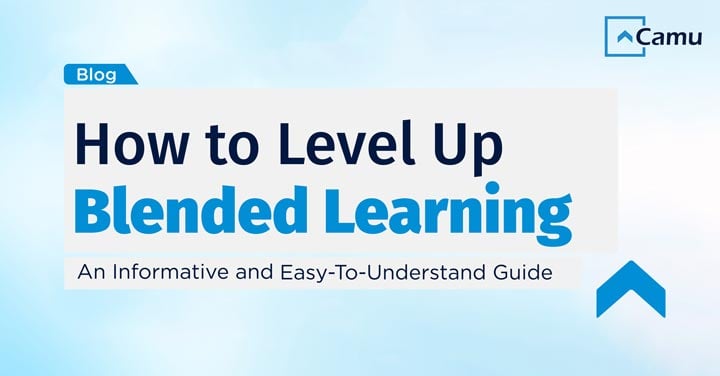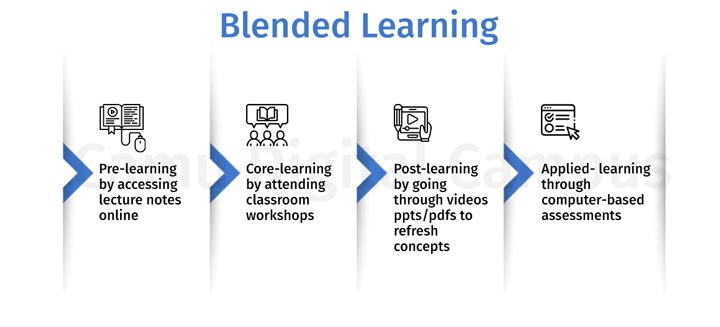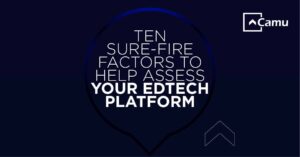
How To Level Up with Blended Learning An Informative and Easy-To-Understand Guide
Education is on the fast track to becoming smarter, more accessible, inclusive, flexible, and personalised.
At the forefront of this change is, the rise of digital technology, coupled with the urgency brought about by the COVID-19 pandemic.
As EdTech – communication and knowledge-sharing tools – becomes more sophisticated, the demand for a hybrid style of education increases.
As an institute of higher education, you’re probably looking to create synergy between online and offline learning.
But how do you go about accomplishing this?
Blended learning is your code, your formula, to building a truly adaptable and multifaceted campus.
And in order to make deep digital transformation a reality for your centre, we’re addressing some of the core questions related to blended learning.
What is Blended Learning?
You may have guessed the basic meaning of this buzzword, but let us take you through its definition and usage.
Blended Learning is a form of dynamic instruction that combines traditional learning methods (face-to-face), with digital learning (screen-to-screen) techniques.
By balancing both, on-campus and online teaching processes, a student is offered the best of both worlds.
A Blended Learning scenario would look a little like this:

As you can see, Blended Learning offers course content in a variety of delivery formats and mediums, including live online webinars, quizzes, videos, and surveys.
Important to note is that the boundaries between Remote Learning, Blended Learning and Hybrid Learning can sometimes blur, with the terms being used interchangeably and interconnectedly.
What Are the Benefits of Blended Learning?
When it comes to this revolutionary model, the advantages only get bigger and better!
Blended Learning helps make education limitless, offering a convenient and reliable solution to teaching and delivery.
It has the potential to render your institute student-centric, future-ready, competitive, and globally recognised.
If planned and executed in an ideal way, it can make the following impact.
For the institute:
- Scalability – Ability to take courses worldwide and increase enrolment numbers.
- Cost-effectiveness – Ability to minimise transportation costs, whilst ensuring optimal use of resources.
- Profitability – Potential to earn higher profits with E-learning cost savings.
- Time Savings – Opportunity to automate tasks and eliminate travel time
For the teacher:
- Knowledge Delivery – Ability to leverage multi-media tools to make teaching more engaging and personalised.
- Communication – Opportunity to communicate with students and management, 24/7.
- Grading and Reporting – Potential to automate administrative tasks, whilst focusing on student performance.
For the student:
- Knowledge Retention – Ability to retain concepts better, due to availability and access to diverse course material online.
- Personalised Learning – Freedom to explore course content that best suits individual learning styles.
- Accessibility – Capable of eliminating geographical barriers.
- Flexibility – Opportunity to learn at any pace or place.
How Do You Improve the Efficacy of Blended Learning?
Blended Learning requires thoughtful planning, and consistent governance, in order for it to be a long-term solution.
Our product specialists have outlined three ways for you to improve your chances of success.
The first step is to determine what processes and tasks should be conducted on campus, and what should be delegated to the digital world. For instance, you can utilise classroom time for valuable interactions, group activities, doubt clarifications, and more, after sharing course material online. The trick is to leverage the right mix of mediums.
The second building block relates to digital literacy, and whether or not students and teachers will be able to adapt to this hybrid structure. To offset any challenges that may arise, institutes must include a quality training and onboarding module. This will help users navigate tools, apps and platforms with ease.
Last but not least, support systems! For students coming from disadvantaged backgrounds, who may not have access to a stable internet connection, there must be a suitable provision. For instance, learning hubs that are accessible to rural students who may not be able to make it to campus, or learn from home.
How does Camu Facilitate Blended Learning?
Camu lets you schedule, conduct, and moderate classes from wherever you are through the magic of the Virtual Classroom.
- User-friendly Design
- Student-centric Features
- Assessment Compatibility
- Automated Reminder Systems
- Recorded Sessions
- Rubrics, discussion forums, and Engagement Analytics
We allow seamless switching between online classes and campus-based classes in a single click, without disturbing course schedules, or having to manually integrate students and staff.
How does this benefit your institute?
- Single platform to schedule lectures for online and on-campus classes.
- Simplified log in from the class schedule in the MyCamu mobile app.
- Choices for user groups to pick an appropriate video conferencing solution.
- Ability to track number of online classes, and attendance, across all departments in real-time.
We combine the power of one – LMS, Operational Dashboards, Video Conferencing, Lecture Scheduling (SIS) – to offer institutes of higher education the most dependable solution.
Blended Learning could be your new motto, with Camu’s advice and assistance!







